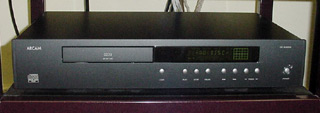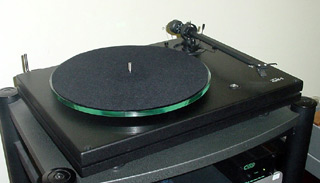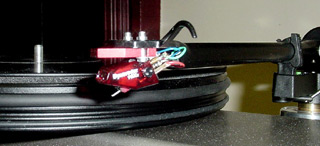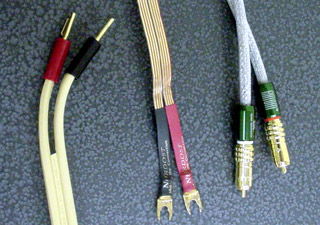![[SoundStage!]](../sslogo3.gif) The Candy Store The Candy StoreBack-Issue Article |
|
April 2004 Stereo-Store Staples I remember as a child that about two or three times a year the local A&P would have a "gigantic stock-up sale" on canned goods. My mother would pile us kids into the back seat of the Buick LeSabre and head for the grocery store. We always had a Buick LeSabre, mostly because we lived in Flint, Michigan and my dad was a General Motors "lifer." I am also convinced that we owned these enormous automobiles for the cavernous trunks they possessed. We traveled quite a bit in my youth, and the trunk of one of these beasts could hold the luggage of several families. I’m not sure you would have much problem hefting a steamer trunk into its hold -- another reason these gas-guzzlers were called "boats," I suppose. We children would frequently ask for the car keys, not to sit in the driver's seat and act like we were driving, but to use the trunk as a fort for make-believe war games. Oh, the violence of our youth. Upon arriving at the A&P, each family member would grab a shopping cart and follow my mother to the end caps of the canned-goods section. Piled in enormous pyramids would be cases upon cases of canned corn, peas, green beans, lima beans, carrots, spinach, asparagus, and the much-dreaded mixed vegetables. Each of our carts would then be loaded to overflowing with case after case from the tin-can garden. After checking out, it was back to the Buick to fill the hold, then home to offload the cargo into various empty corners of the garage and utility room. If asked the reason for purchases in such inflated proportions, my mother would simply reply, "It’s all staples. They’ll certainly be put to good use." As a child I had some questions surrounding that phrase "good use," especially when staring at a four-foot stack of mixed vegetables. "Good use"
The very first product that came to mind when I thought of audio staples was the Triangle Titus loudspeaker (right). Triangle also makes the larger and much-raved-about Celius, as well as the towering $32,000 Magellan. However, it is the diminutive little Titus that has caused more customers' jaws to drop than any component I can think of regardless of cost. I still remember the couple that came into the store looking to put together a simple system. Their son worked for our custom-installation branch and was more into the crash and bang of dedicated home theater. They, on the other hand, were music lovers. The woman took the chair, and I played a recording of Jacintha singing "Danny Boy" through a pair of Titus loudspeakers. In a few moments I noticed tears streaming down the woman’s cheeks. The couple listened to no other speakers that day. The reaction has not always been so dramatic, but always positive. The Titus is easy to drive and responds well to both tube and solid-state amplification. A 3-watt SET in a small room is magical with these guys. They throw an enormous soundstage and image like the dickens. The Titus uses a little 5" paper midbass driver (run full-range) and a horn-loaded metal-dome tweeter. The lack of any real crossover may contribute to the ultimate transparency of these speakers. Paired with a REL sub, the Titus is part of a speaker system that is very hard to beat for just over $2000. We have a customer who is a real hobbyist. Although he has bought electronics from us, he has been building his own speakers for years. He always felt he could get more for his money by investing a little sweat equity. That changed when he heard the Titus. The price of the Triangle Titus just went up from $495 to $595 a pair. Our response to price increases is usually not a positive one. In this case we simply thought, "It’s about time." REL subs would have to be at the top of any list. I have yet to find an application where a REL didn’t take a system to a level well beyond the invested cost. Better soundstaging, focus, and clarity are all gained along with accurate bass. Read more on this in my previous column on the REL sub systems. The Simaudio Moon i-3 integrated amplifier ($1750) was a fairly easy choice as well. Yes, we sell all of the big-dog stuff. Conrad-Johnson, Brinkmann, YBA, Quad, Bel Canto, and Thor Audio are among the amplifiers that have earned floor space in our store. A pair of Simaudio Moon W-5 amplifiers are the best-sounding amps we have found for the state-of-the-art Dali Megalines ($40,000). However, it is the $3000-$6000 systems that provide a great deal of our two-channel business. Frequently these systems are based around a quality integrated amplifier. That said, it is the little i-3 integrated that has earned its title of staple. We sold this integrated amp for years as the i-5080. It received much positive press as a simple high-current design with lots of finesse. Today it has evolved into the i-3, and it still receives lots of accolades. The i-3 is a very simple-looking integrated with a black faceplate, a large red LED display, and buttons for volume and source selection. The remote is a heavy steel affair (don’t drop it on your foot or end table). The amp is rated at 100Wpc into 8 ohms and has current to spare. There are a lot of integrated amplifiers that compete in this range. Most run out of current if used on a difficult speaker or pushed too hard. The Moon i-3 remains strong. It has amazing bass control over even the most difficult speakers. The top frequencies are extended and airy, yet never bright. One important tip about getting the best from Moon amps: Give them several days of burn-in before critical listening and never turn them off. Perhaps the biggest compliment you can give this amp is that it isn’t fussy about what it plays with. It just works. For digital sources we still find ourselves selling CD players. Although we offer SACD and DVD-A options, the majority of customers are interested in a good CD source. For years the Arcam players have proved a great value to our store and our customers. All models provide an excellent sense of rhythm, a sweet midrange, and a detailed yet smooth top end. As you move up the line, the models just do these things better. Arcam has always put function over form. The units are basic in looks, but beautiful in sound. These players also offer an upgrade path that is attractive to customers who can afford entry-level gear now but already thirst for the next step. A customer can purchase one of the less expensive models now and later have it upgraded to one of the better models.
We have been especially impressed with the Arcam CD73T ($699). This player is used as the base player in a room where we demo systems up to $8000. I recently had a customer who was contemplating whether to buy a new CD player or an external DAC for his DVD player. We ended up comparing the CD73T to the Bel Canto DAC2. Guess what? The Bel Canto was better, but not by a bunch. We were all amazed at just how well the Arcam compared every time we switched back. A high compliment indeed! In the last six months or so, we have sold more turntables than CD players. That warms the heart of an analog guy like me. A large percentage of these sales have been to analog rookies or people with records that have been sitting unplayed. We do analog at all levels, right up to Schroeder tonearms and hand-built Allerts cartridges. However, the turntable responsible for bringing more people into the fold than any other in our store is the Music Hall MMF-5. The MMF-5 is a simple and elegant design with a split plinth (for isolating the motor from the bearing) a glass platter, and a good tonearm. At $650, the Music Hall MMF-5 comes with a Goldring G1012 cartridge and will show even the deepest disbeliever what all the fuss is about. It embarrasses CD players at double its price. While on the subject of analog, I would be remiss in not adding the Dynavector 10X5 cartridge to the list of staples. Although this cartridge costs a little more than a gateway product, $360, it does demonstrate why the big dogs run with moving-coil cartridges. It has a sweet, detailed presentation that makes you forget about the equipment and listen to the music. It works well with every 'table/'arm combination I’ve tried it on. It has a high 2.5mV output, which allows it to work with moving-magnet phono sections. The other Dynavector cartridges will give you more, but this one is the best buy by far. The last items on our staples shopping list are cables, which are usually very system dependent. We carry several choices and offer a generous home-trial policy. However, three cables stand out as staples for those $3000-$6000 systems. Nordost Flatline Gold ($3.99 per foot) is a flat ribbon-like cable that uses high-purity copper covered by Teflon. It sounds fast with a nice top end and great focus. A quick demo against zip cord or cheap mega-wire always shows customers that wire really does make a difference. It also works well for very long runs, where most wire would get way too expensive. The other great bargain is the van den Hul CS122 Hybrid speaker cable. This cable uses silver-coated copper covered with carbon and wrapped in a rubbery Hulliflex jacket. The van den Hul is smoother and warmer than the Nordost, and seems to really do the spatial thing well. It works especially well with speakers that tend to be a little on the bright or forward side. They are a match made in heaven for Triangle speakers. We carry both of these cables in bulk rolls, which allows us to terminate them in a variety of configurations. Finally, at $139 per meter pair, the Tara Labs RSC Axiom interconnect is a steal. This is at the entry level of Tara’s Rectangular Solid Core technology. This interconnect is detailed and transparent like no other I have heard in its price range. It easily competes with many $250-$450 interconnects. We always keep plenty of back stock on this cable. Grab a cart After I made the list, I noticed that most of the items I would consider staples fell in the low to middle price ranges, where the majority of purchases are made. This points out the issue of systems getting more finicky as cost goes up. Often helping others find just the right item is fun (this is where the hobby part comes in), but at other times it's frustrating. Sometimes I just want to sit down with a Simaudio Moon i-3 hooked up a pair of Triangle Titus speakers, cue up a record on a Music Hall MMF-5, and just let the music play. I’ve sold more systems that way. ...Bill Brooks |
|
|
|
![[SoundStage!]](../sslogo3.gif) All Contents All ContentsCopyright © 2004 SoundStage! All Rights Reserved |
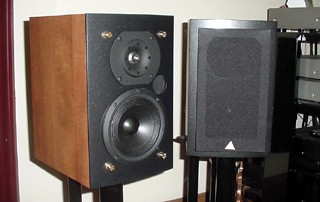 It was with this phrase in
mind that I began to think about products in our store that have been staples. Sure, there
are products that come and go and new lines that find a home. Our store has one of the
largest selections of audio products in the Midwest. However, it was not too difficult to
come up with a list of several products that find themselves a part of quality systems on
a regular basis.
It was with this phrase in
mind that I began to think about products in our store that have been staples. Sure, there
are products that come and go and new lines that find a home. Our store has one of the
largest selections of audio products in the Midwest. However, it was not too difficult to
come up with a list of several products that find themselves a part of quality systems on
a regular basis.